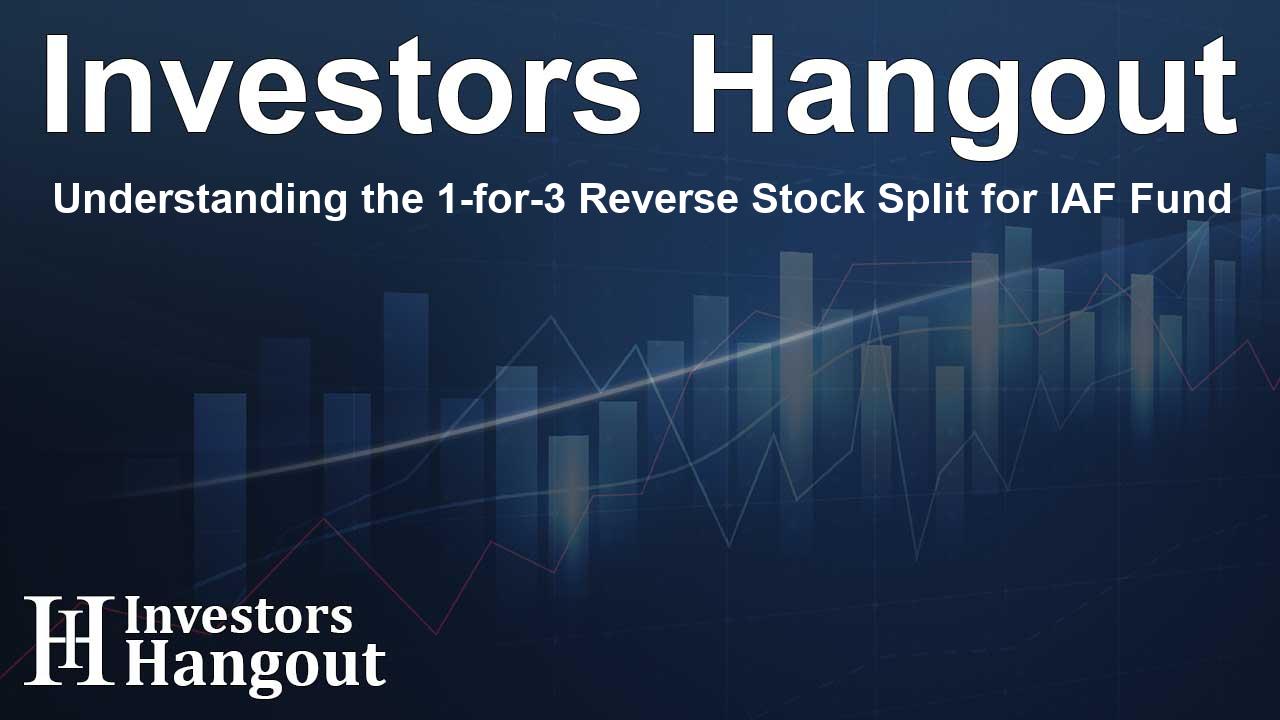Understanding the 1-for-3 Reverse Stock Split for IAF Fund

The 1-for-3 Reverse Stock Split Explained
The abrdn Australia Equity Fund, Inc. (NYSE: IAF), a closed-end investment fund, is set to implement a 1-for-3 reverse stock split of its shares. This decision, made by the Fund's Board of Directors, aims to streamline the stock's valuation and enhance its appeal in the market.
What is a Reverse Stock Split?
A reverse stock split is a corporate action where a company reduces the number of its outstanding shares while simultaneously increasing the share price proportionally. In this case, every three shares currently held by shareholders will be consolidated into one share. This process doesn’t change the overall value of a shareholder's investment; it merely alters the number of shares owned and their corresponding per share price.
Impact on Shareholders
The primary aim of this reverse stock split is to potentially elevate the per share market price of the Fund’s common stock. Following the split, shareholders will hold fewer shares, but the net value per share will rise. The total investment value remains unchanged, maintaining each stockholder's proportional ownership in the Fund.
Why is the Fund Implementing the Split?
The Board of Directors, along with management, believes that a higher share price can attract a broader range of investors. A reverse stock split may help mitigate the transaction costs for buyers and sellers in the secondary market, enhancing liquidity for current and prospective investors.
Details of the Stock Split
The reverse stock split is anticipated to occur before the NYSE opens on a specified date. While the new trading structure is expected to start promptly, notice will be provided to shareholders regarding the specifics. The ticker symbol will remain IAF, ensuring continuity in trading despite the structural changes.
Quarterly Distribution Commitments
Despite the share consolidation, the Fund will uphold its commitment to quarterly distributions based on the rolling average of its net asset value (NAV). The annual distribution rate is set at 10%, assuring shareholders that they will continue to receive returns, albeit potentially at a higher per-share amount due to a decreased share count. The distribution calculations will, however, remain aligned with the existing NAV approach.
Handling of Fractional Shares
It's important for investors to understand that no fractional shares will be issued as a result of the reverse stock split. Instead, any fractional shares resulting from the consolidation will be aggregated and sold by the Fund's transfer agent on the NYSE, with shareholders compensated proportionally based on their fractional shares.
Communication to Shareholders
Following the reverse stock split, shareholders will receive updates from Computershare Trust Company, N.A., the Fund's transfer agent, detailing the changes and how it affects their investments. It's crucial for shareholders to stay informed about the developments and the implications of this reverse stock split on their holdings.
Market Implications
Investors should keep in mind that the market price of closed-end fund stocks can fluctuate due to various external factors. This reverse stock split is a strategic move to bolster investor interest and enhance market engagement with the Fund's shares. The trading dynamics may change, and while a split-adjusted price may look more appealing, the actual trading context will determine the market realities of the shares.
Frequently Asked Questions
What is a reverse stock split?
A reverse stock split reduces the number of outstanding shares, increasing the per-share price while maintaining the overall value of the investment.
How will the reverse split benefit me as a shareholder?
The reverse split may enhance the stock price, making it more attractive to a wider range of investors, potentially boosting liquidity.
What happens to fractional shares after the split?
No fractional shares will be issued. Any fractions will be consolidated, sold, and proceeds distributed among shareholders.
Will my investment value change after the split?
The total value of your investment will not be affected; however, the number of shares you own will decrease while the price per share increases.
When will the reverse stock split take effect?
The split is expected to occur on a specified date prior to market open, and shareholders will be notified accordingly.
About The Author
Contact Lucas Young privately here. Or send an email with ATTN: Lucas Young as the subject to contact@investorshangout.com.
About Investors Hangout
Investors Hangout is a leading online stock forum for financial discussion and learning, offering a wide range of free tools and resources. It draws in traders of all levels, who exchange market knowledge, investigate trading tactics, and keep an eye on industry developments in real time. Featuring financial articles, stock message boards, quotes, charts, company profiles, and live news updates. Through cooperative learning and a wealth of informational resources, it helps users from novices creating their first portfolios to experts honing their techniques. Join Investors Hangout today: https://investorshangout.com/
The content of this article is based on factual, publicly available information and does not represent legal, financial, or investment advice. Investors Hangout does not offer financial advice, and the author is not a licensed financial advisor. Consult a qualified advisor before making any financial or investment decisions based on this article. This article should not be considered advice to purchase, sell, or hold any securities or other investments. If any of the material provided here is inaccurate, please contact us for corrections.
